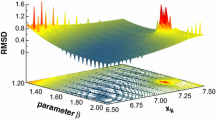Summary
The paper deals with two topics related to the problem which reference state is better for many-body perturbation theory: restricted Hartree-Fock (RHF) or unrestricted Hartree-Fock (UHF)? The first topic concerns the potential surfaces. Several examples are presented to show shortcomings of the two approaches and a simple way is presented which seems to give a useful potential curve in the whole range of interatomic distances by a composition of RHF and UHF potential curves. The second topic concerns the many-body perturbation theory for open-shell systems in the RHF formalism. The method is critically examined and compared with the ordinary many-body perturbation theory using UHF as the reference. This examination of many-body techniques provides also some insight into the problems inherent of the SCF theory: spin contamination from higher multiplets, localization of orbitals, and self-consistency effects.
Similar content being viewed by others
References
Shavitt I, Rosenberg BJ, Palalikit S (1976) Int J Quant Chem Symp 10:33
Hubač I, Čársky P (1980) Phys Rev 22A:2392
Paldus J, Čížek J (1975) Adv Quantum Chem 9:105
Bartlett RJ, Silver DM (1976) in: Calais JL, Goscinski O, Linderberg J, Öhrn Y (eds) Quantum science, Plenum Press, New York, p 393
Pople JA, Binkley JS, Seeger R (1976) Int J Quant Chem Symp 10:1
Roos BO, Siegbahn PEM (1977) in: Schaefer III HF (ed) Modern theoretical chemistry Vol 3, Plenum Press, New York, p 277
Klimo V, Tiňo J (1980) Mol Phys 41:483
Klimo V, Tiňo J (1980) Mol Phys 46:541
Bartlett RJ, Purvis GD (1980) Phys Scripta 21:255
Bartlett RJ (1981) Ann Rev Phys Chem 32:359
Sosa C, Schlegel HB (1987) J Am Chem Soc 109:7007
Sosa C, Schlegel HB (1986) Int J Quant Chem 29:1001
Sosa C, Schlegel HB (1987) Int J Quant Chem 21:267
Schlegel HB (1986) J Chem Phys 84:4530
Duchovic RJ, Hase WL, Schlegel HB, Frisch MJ, Raghavachari K (1982) Chem Phys Lett 89:120
Brown FB, Truhlar DG (1985) Chem Phys Lett 113:441
Čársky P, Špirko V (1986) unpublished results
Gerber WH, Schumacher E (1978) J Chem Phys 69:1692
Roothaan CCJ (1960) Rev Mod Phys 32:179
Cederbaum LS, Schirmer J (1974) Z Phys 271:221
Hubač I, Čársky P (1978) Top Curr Chem 75:97
Čársky P, Zahradník R, Hubač I, Urban V, Kellö V (1980) Theor Chim Acta 56:315
Čársky P, Hubač I (1981) Coll Czech Chem Commun 46:1324
McDowell K (1981) Int J Quantum Chem 19:271
Kvasnička V, Biskupič S, Laurinc V (1981) Mol Phys 42:1345
Wilson S (1982) Theor Chim Acta 61:343
Čársky P, Hubač I, Staemmler V (1982) Theor Chim Acta 60:445
Čársky P, Svrček M, Hubač I, Brown FB, Shavitt I (1982) Chem Phys Lett 85:17
Balková A (1985) Thesis, Slovak Academy of Sciences and Comenius University, Bratislava
Hubač I, Sadlej AJ (1982) Czech J Phys B32:1116
Kelly HP (1969) Adv Chem Phys 14:129
Tuan DFT, Epstein ST, Hirschfelder JO (1966) J Chem Phys 44:431
Adamowicz L, Sadlej AJ (1978) Chem Phys Lett 53:337
Sadlej AJ (1979) J Phys Chem 83:1653
Sadlej AJ (1980) Acta Phys Polon A57:879
Bartlett RJ, Purvis III GD (1979) Phys Rev 20A:1313
Diner S, Malrieu JP, Claverie P (1969) Theor Chim Acta 13:1, 18
Kapuy E, Csépes Z, Kozmutza C (1983) Int J Quant Chem 23:981
Čížek J, Förner W, Ladik J (1983) Theor Chim Acta 64:107
Laidig WD, Purvis GD, Bartlett RJ (1985) J Phys Chem 89:2161
Diercksen GHF, Sadlej JA (1981) J Chem Phys 75:1253
Hubač I, Čársky P (1983) Int J Quant Chem 24:141
Musher JI (1967) J Chem Phys 46:369
Rossky PJ, Karplus M (1980) J Chem Phys 72:6085
Klimo V, Tiňo J (1984) Int J Quant Chem 25:733
Knowles PJ, Handy NC (1988) J Chem Phys 88:6991
Rittby M, Bartlett RJ (1988) J Phys Chem 92:3033
Watts J, Bartlett RJ (1990) J Chem Phys 93:6104
Sekino H, Bartlett RJ (1986) J Chem Physe 85:3945
Scuseria GE (1991) Chem Phys Lett 176:28
Neogrády P, Urban M, Hubač I (to be published)
Wolinski K, Sellers HL, Pulay P (1987) Chem Phys Lett 140:225
Saebo S, Pulay P (1987) J Chem Phys 86:914
Pulay P, Saebo S (1986) in: Jorgensen P, Simons J (eds) Geometrical derivatives of energy surfaces and molecular properties. Reidel, Dordrecht, p 95
Pulay P, Saebo S (1986) Theoret Chim Acta 69:357
Gill PMW, Pople JA, Radom L (1988) J Chem Phys 89:7307
Purvis III GD, Sekino H, Bartlett RJ (1988) Coll Czech Chem Com 53:2203
Author information
Authors and Affiliations
Rights and permissions
About this article
Cite this article
Čársky, P., Hubač, I. Restricted Hartree-Fock and unrestricted Hartree-Fock as reference states in many-body perturbation theory: a critical comparison of the two approaches. Theoret. Chim. Acta 80, 407–425 (1991). https://doi.org/10.1007/BF01117420
Received:
Revised:
Accepted:
Issue Date:
DOI: https://doi.org/10.1007/BF01117420




